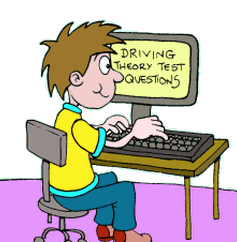Show me tell me test
If you've not heard of the "show me tell me" test, then this is something
that happens at the start of the driving practical test as opposed to on the
theory test. They ask one of each of the two types of question: that is
they will ask you to show you one thing and tell you one thing.
If you get either of them wrong then that counts as a driving test fault. In
total there are 19 questions that can be asked.
Questions will ask you a variety of different things. For instance they
might ask you to open up the bonnet and say how you would check the level of
engine coolant. Or perhaps tell them where the brake fluid reservoir is.
Some questions clearly are not obvious so you will need to learn the answers
beforehand - it is worth studying all the questions and learning the
answers. Your driving instructor should of course prepare you well for this
element of the test and you will practice opening the bonnet and identifying
the various locations of things that you need to know about, which you can
then repeat in the driving test proper.
Other questions will be about inside the car rather than under the bonnet:
for instance questions about how to put headlights on a certain beam, how to
turn on the rear fog lights and other information along those lines.
It is also worth studying an "under the bonnet" diagram that has the various
elements that you need to know about marked. For instance the location of
things such as the engine coolant, power steering fluid, dipstick, engine
oil, brake fluid and the windscreen fluid.
Related Articles...
What to do at a box junction
The box junction is quite common but despite this there are a whole wide range of ways in which different drivers interpret what they are supposed to do at them so you will see different behaviours...
Risk factors when driving: snow and ice
When the snow is falling, there is one big problem - it is hard to see far infront. So like fog, reduced visibility is the problem with snow. And when there is heavy snowfall it can be very hard...
How does the hazard perception test work
The hazard perception test is the second part of the driving theory test, and it was introduced towards the end of 2002.
There are two parts to the theory test, and the second part of the test...
Your driving licence: getting it back
As the New Drivers Act article outlines, if you get six penalty points or more in the first two years of having a licence, then it is revoked and you have to retake both tests: the theory and the...
More on Motorway Driving
Signs that let you know there is a motorway ahead are rectangular, and they have a green background. This shows that they are information signs on a primary road.
The part with the reference...
Tips on preventing car crime
It is an obvious statement that nobody wants their car to be broken into or have items stolen from their car. Yet despite this some drivers take little care in discouraging theft.
There are...
Professional driving instructors
When you learn to drive, you have the choice who teaches you. The majority of people decide to learn through a professional driving instructor and often through a major school of...
The day of the theory test
On the day of the theory test you may well feel nervous. As with any test or examination of any kind this is of course natural as everybody is anxious to do their best and to pass the...
Being aware of potential hazards
Having the maximum time possible to react to hazards is important and can be the difference between an awkward situation or even an accident and continuing safe driving.
This requires you not...
Tyre pressure checking
The one check that everyone knows to perform is to check the pressure of their tyres, but a visual inspection is not enough. Clearly you can spot something really obvious this way, such as if a...
Back to home page of driving theory test questions

